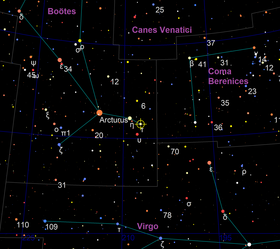Tau Boötis
| Observation data Epoch J2000.0 Equinox J2000.0 | ||
|---|---|---|
| Constellation | Boötes | |
| Right ascension | 13h 47m 15.7382s[1] | |
| Declination | +17° 27′ 24.810″[1] | |
| Apparent magnitude (V) | 4.50[2] (4.46 to 4.52)[3] | |
| Characteristics | ||
| Spectral type | F6V + M2[4] | |
| B−V color index | 0.48[2] | |
| Variable type | Suspected[3] | |
| Absolute magnitude (MV) | 3.38[5] | |
Argument of periastron (ω)(secondary) | 290.7+13 −10° | |
| Details | ||
| τ Boo A | ||
Rotational velocity (v sin i) | 5.0[7] km/s | |
LTT 14021 | ||
| Database references | ||
| SIMBAD | data | |
| A | ||
| B | ||
Tau Boötis,
Stellar components
The system is a
The primary star, Tau Boötis A is a yellow-white dwarf. It is 35 percent more massive and 42 percent larger than the
Tau Boötis B (with a capital B, as opposed to the planet) is a dim, 11 mag red dwarf with only about half the mass and radius of the Sun. It orbits the primary star at an average distance of about 220
Planetary system
In 1996 the
| Companion (in order from star) |
Mass | Semimajor axis (AU) |
Orbital period (days) |
Eccentricity | Inclination | Radius |
|---|---|---|---|---|---|---|
| b | 6±0.28 MJ | 0.0481 ± 0.028 | 3.312463 ± 0.000014 | 0.023 ± 0.015 | 44.5 ± 1.5° | — |
Naming controversy
The planet and its host star was one of the planetary systems selected by the International Astronomical Union as part of NameExoWorlds, their public process for giving proper names to exoplanets and their host star (where no proper name already exists).[16][17] The process involved public nomination and voting for the new names, and the IAU announced the new names in mid-December 2015.[18] However, the IAU annulled the vote for the system, as the winning names ("Shri Ram Matt" for the star and "Bhagavatidevi" for the planet)[17] were judged not to conform with the IAU rules for naming exoplanets due to the political activities of the namesake people.[19] The names garnered the majority of the votes cast for the system, and also making up a significant proportion of all votes cast as part of the contest.[17]
See also
References
- ^ S2CID 244398875. Gaia DR3 record for this source at VizieR.
- ^ Bibcode:1999A&A...352..495M.
- ^ S2CID 125853869. Search for: NSV 6444.
- ^ ISSN 0004-6361.
- S2CID 8642707.
- ^ S2CID 53490623.
- ^ ISSN 0004-6361.
- ^ Friedlander, Blaine (16 December 2020). "Astronomers detect possible radio emission from exoplanet". Phys.org. Retrieved 16 December 2020.
- .
- S2CID 119089082.
- . A119.
- doi:10.1086/310444.
- S2CID 118503912.
- S2CID 56317105.
- S2CID 119067572.
- ^ "NameExoWorlds: An IAU Worldwide Contest to Name Exoplanets and their Host Stars". International Astronomical Union. 9 July 2014. Retrieved 8 January 2016.
- ^ a b c "The ExoWorlds". NameExoWorlds. International Astronomical Union. n.d. Retrieved 8 January 2016.
- ^ "The Process". NameExoWorlds. International Astronomical Union. 30 November 2015. Archived from the original on 15 August 2015. Retrieved 8 January 2016.
- ^ "Final Results of NameExoWorlds Public Vote Released". International Astronomical Union. 15 December 2015. Retrieved 8 January 2016.
External links
- "VizieR: HR 5185". Centre de Données astronomiques de Strasbourg. Retrieved 2009-05-15.
- "VizieR: CCDM J13473+1727". Centre de Données astronomiques de Strasbourg. Retrieved 2009-05-15.
- "Aladin Previewer: Tau Boötis". Centre de Données astronomiques de Strasbourg. Retrieved 2009-05-15.
- Schirber, Michael (23 May 2005). "Role Reversal: Planet Controls a Star". SPACE.com. Retrieved 2008-06-25.
- "Notes for star Tau Boo". Extrasolar Planets Encyclopaedia. Archived from the original on September 29, 2007. Retrieved 2008-06-25.
- "Tau Boötis 2". SolStation. Retrieved 2008-06-25.
- "Tau Bootis". The Planet Project. Archived from the original on 2008-05-17. Retrieved 2008-06-25.

